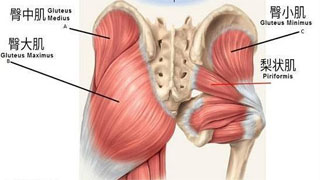
The piriformis muscle is located on the posterior wall of the pelvis and is triangular in shape. It starts from the anterior side of the 2nd to 5th sacral vertebrae, with muscle fibers concentrated outward. It exits the pelvis through the greater sciatic foramen and ends at the top of the greater trochanter of the femur. When approaching fixation, this muscle contracts, causing the thigh to abduct, rotate outward, and extend backward. When the distance is fixed, one side contracts to turn the pelvis to the same side; Contraction on both sides causes the pelvis to tilt backwards. The piriformis muscle is innervated by the muscle branches (S1-S3) of the sacral plexus.
Pear shaped muscle syndrome, what is pear shaped muscle strain
Pear shaped muscle strain is the tearing of one or more muscle fibers that make up the pear shaped muscle. Physical therapy can successfully treat the symptoms of piriformis muscle strain.
How does pear shaped muscle strain occur?
The piriformis muscle is a deep muscle in the buttock region that connects the sacrum and femur. Its function is to rotate and abduct the hip, making it a very important stabilizing muscle. Pear shaped muscle strain often occurs due to overuse injury and repeated jumping, sprinting, and lunge movements.
What are the symptoms of piriformis muscle strain?
The buttocks area usually experiences deep pain, and sometimes the back of the thighs, calves, and feet also feel pain. Climbing stairs, changing direction, and performing jumping or squatting movements may be difficult. This area may be tender and more superficial muscles (such as the gluteus maximus) may experience spasms. Other symptoms include:
Gait issues
weakness
Narrowing the scope of activities
Swelling/Inflammation
What should I do if I have a pear shaped muscle strain?
If you suspect that you may have a pear shaped muscle strain, you should see a physical therapist as soon as possible. They can provide you with a comprehensive assessment and accurately diagnose your injury in order to develop a treatment plan for you. Wrapping ice packs or frozen peas in a damp towel can alleviate pain and swelling around the area. For more severe injuries, MRI scans may be necessary to confirm the diagnosis.
Physical therapy for pear shaped muscle strain
The main physical therapy for pear shaped muscle strain is personalized strengthening and stretching plans. This will be developed by your physical therapy based on your current abilities and goals. Other treatment methods include massage and electrotherapy techniques such as ultrasound to alleviate pain and optimize the healing process. Other treatment methods include:
Spa treatment
Soft tissue therapy
Manipulation/Mobilization
acupuncture
What should I not do if I have a pear shaped muscle strain?
Hydrotherapy involves exercising in warm water and specific physical therapy techniques to help relieve pain, relax and strengthen muscles, increase blood circulation, and improve function. Hydrotherapy can also maximize the mobility of adults and children with limited mobility in water.
If you experience any of the above symptoms and believe that you have a pear shaped muscle strain, you should immediately stop any activities that worsen the symptoms. This includes jumping, sprinting, and lunges, which may be key features of your sport or hobby. Don't ignore your symptoms, as they can delay your recovery and may make the injury more chronic (long-term) and difficult to resolve.
Will the pear shaped muscle strain have any long-term effects?
If you don't start a physical therapy plan immediately after noticing symptoms of piriformis muscle strain, your injury may become chronic and more persistent. This will prolong your recovery time and you will need more time to resume your exercise or hobbies.


